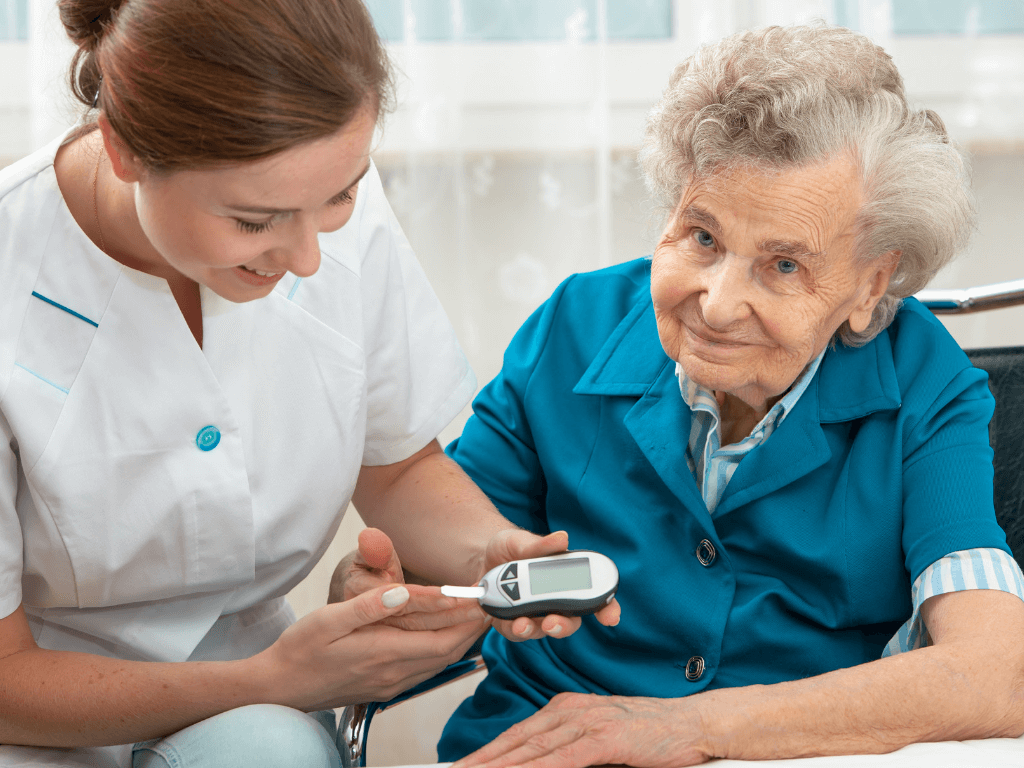What is diabetes?
Diabetes has the potential to make life difficult for people of just about any age though it strikes senior citizens particularly hard. Out of the nearly 500 million individuals who have been diagnosed with diabetes, about 34 million of them live in the United States. Sadly, diabetes in older adults is that much more challenging to manage. However, the assistance of a home care provider makes it easier to remain in one’s house with diabetes and/or other medical conditions.
Best defined as a condition in which a patient has elevated blood sugar levels, diabetes occurs when one’s body cannot create sufficient insulin. The islet cells within the pancreas generate the insulin hormone that opens cells, permitting sugar from food to move inward. The body then uses the glucose to create energy.
Types of diabetes
There are two primary types of diabetes in the form of Type 1 diabetes and Type 2 diabetes. Type 1 diabetes is more severe when compared with Type 2 diabetes and other types. Only about 5% of those saddled by diabetes have the Type 1 variety. Type 1 diabetes was previously referred to as “juvenile diabetes” as it typically formed in teens and kids. However, it is possible for an individual of any age to develop both types of diabetes.
Type 1 diabetes is characterized by the immune system going on the offensive against the islet cells that generate insulin within the pancreas. The islet cells identify the presence of glucose within the blood, engage in the attack and result in autoimmune disease. However, the attack results in the patient no longer being capable of generating his or her own insulin.
Type 2 diabetes, also known as non-insulin dependent diabetes, is much more common than Type 1 and other types. Type 2 diabetes typically develops after the patient reaches the age of 35. Patients with this type of diabetes are capable of generating some of their own insulin. However, the insulin generated might not be sufficient. If the insulin does not open the cells with in the body to permit the entry of glucose, there is insulin resistance. For the most part, Type 2 diabetes typically strikes those who live a sedentary life and are overweight, meaning it is more likely to impact the elderly who are retired or work office jobs in which they remain seated throughout the majority of the day.
Symptoms of diabetes in elderly
At this point, you are likely wondering, “Does the risk of diabetes increase with age?”. Indeed, the older one is, the greater the chances are that he or she will become diabetic. In fact, there is a decent chance one of the elderly individuals in your life is diabetic and you just don’t know it yet.
If your parent, grandparent or other aging relative displays any of the symptoms of diabetes as descried below, meet with a doctor as soon as possible. Examples of diabetes symptoms in the elderly include incontinence, dehydration, confusion, dry mouth, dry eyes and neuropathy. In some situations, the elderly patient has diabetes along with hypertension and dyslipidemia.
Beginning signs of diabetes in aging adults
If your parent or other aging loved one complains of any of the common initial signs of diabetes in the elderly, schedule an appointment with his or her treating physician. Examples of diabetes symptoms in the elderly to be on the watch for include heightened excretory system voiding, numbness and tingling, increase in appetite, unusual weight loss, irritated skin, fatigue and visual disturbances.
Normal blood sugar levels for seniors
There is no exact blood sugar level every single senior should strive toward. However the normal blood sugar level range is between 70 and 130 mg/dL prior to consuming food. It is recommended that senior citizens have a 180 mg/dL blood glucose level or less within two hours of eating. However, the blood sugar level ideal for the senior in your life will ultimately be determined by his or her doctor.
How to manage diabetes at home
Managing diabetes at home is that much easier with the help of a home health assistant. Your parent’s home health care provider will provide insulin and medication reminders, assist with meal preparation and ultimately make it that much easier to live comfortably even when dealing with diabetes. Combine home care with professional medical care in a traditional office setting along with specialized care from a diabetes management clinic and you will rest easy knowing you have done your part to maintain a high quality of life.
Meals for diabetic seniors
Managing diabetes the right way centers on regulating blood glucose. Those who adhere to recommended guidelines in the context of dietary intake will find managing diabetes as a senior is easier than initially expected. Monitoring carbohydrate quantity intake is central to glycemic control. Ideally, the meals the diabetic in your life will consume will be highlighted by complex carbohydrates from vegetables, whole grains and fruits as opposed to salty and sugary delights.
The consumption of the recommended daily intake of whole grains and fiber will also help the diabetic senior you love live comfortably. However, making three meals from scratch on a daily basis is not easy nor practical for a senior citizen of a certain age or one saddled by certain ailments. The solution is to rely on a home health care provider who can administer insulin injections, identify and help maintain normal blood sugar levels for seniors and otherwise assist with managing diabetes in the elderly.

Home health care for diabetic patients
Wouldn’t it be nice if a home health care professional came directly to the home of your loved one to provide custom-tailored care? If your parent or other relative has diabetes or another condition, disease, illness or ailment that makes it difficult to live a normal life in the house, don’t hesitate to ask for help. A home health care service provider will help with the activities of daily living including meal prep, medication, monitoring blood sugar and more.


